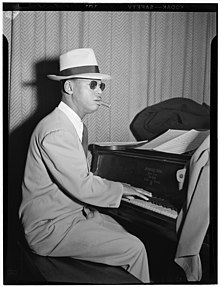Earl Hines
Earl Kenneth "Fatha" Hines (* 28. December 1903 in Duquesne , Pennsylvania ; † 22. April 1983 in Oakland , California ) was an American jazz - pianist and bandleader .
Life
Hines' father played as a trumpeter in the Eureka Brass Band , his mother was an organist. Hines first learned cornet , but then switched to piano , on which he received private lessons in Pittsburgh from 1914 . He was soon playing in clubs. In 1922 he moved to Chicago. In 1926 he became a member of Carroll Dickerson's band . Here he met Louis Armstrong , whom he greatly admired and with whom he recorded two milestones in jazz history in 1928: "West End Blues" and "Weather Bird". He also worked for Sammy Stewart and Jimmy Noone . He had his first hit in the charts in September 1933 with the solo number "Fifty-Seven Varieties."
From 1928 to 1947 he had his own band , which he soon expanded to include the big band format . As a band leader in the 1930s, he had leading jazz musicians under contract such as Darnell Howard , Trummy Young and Freddy Webster . With his sextet he made recordings with Ray Nance , Johnny Hodges , Flip Phillips , Oscar Pettiford and singers like Sarah Vaughan and Johnny Hartman . In 1940 he had his last hit in the charts with " It Had to Be You ". At the beginning of the 1940s Dizzy Gillespie , Charlie Parker and Billy Eckstine played in his band . This gave Hines' band the reputation of being a cradle of bebop .
From 1948 to 1951 he played in Armstrong's All Stars Band . He then worked on the west coast and in 1957 went on a European tour with Jack Teagarden . From 1964 he made a comeback with a series of solo concerts. He worked with Budd Johnson in a trio or quartet and became known worldwide through a number of tours. In 1965, the critics voted him into the Down Beat Hall of Fame .
The so-called trumpet style ( trumpet style pianist) is associated with Hines , with which he reproduced Armstrong's playing style on the piano. This makes him a pioneer of the swing piano style, which Teddy Wilson perfected. Earl Hines had a great influence on the development of the jazz piano and is considered one of the outstanding performers on this instrument. His style is an important link between traditional and modern jazz. He also tried out new timbres. On February 26, 1940, he was already using an electric storytone piano to record Body and Soul and Child of a Disordered Brain .
Earl Hines and His Orchestra
Discography

- Discographic information (selected from The Penguin Guide to Jazz )
- Earl Hines Plays Duke Ellington (New World, 1971-75) - solo
- Earl Hines Plays Duke Ellington Vol. 2 (New World, 1972-75) - solo
- Earl Hines Plays Cole Porter (New World, 1974)
- Hot Sonatas (Chiaroscuro) with Joe Venuti
- In New Orleans (Chiaroscuro - 1977) - solo
- Master of Jazz Vol. 2 (Storyville 1974, ed. 1984)
- Four Jazz Giants (Solo Art 1997, compilation of the LPs My Tribute to Louis , Hines Does Hoagy , Hines Comes in Handy from 1971)
Literature (selection)
- George T. Simon : The Big Bands. With a foreword by Frank Sinatra. 3rd revised edition. Macmillan Publishing, New York and Collier Macmillan Publishers, London 1974, pp. 256f.
- Stanley Dance : The World of Earl Hines. Scribners, New York 1977 and Da Capo, New York 1979.
- Wolfram Knauer : Earl Hines. In: jazz classics . Two volumes edited by Peter Niklas Wilson . Reclam, Stuttgart 2005 ( RUB ), ISBN 3-15-030030-4 , Volume 1, pp. 118–126 [with selected listening recommendations and references].
Web links
- Literature by and about Earl Hines in the catalog of the German National Library
- Discography of the solo recordings
- Earl Hines Orchestra discography
Remarks
- ↑ Based on the biography of Stanley Dance; Hines himself gave 1905 as the year of birth, which most jazz historians believe is wrong.
- ↑ Number 57 in the title referred to the 57 different sauces offered by Heinz Food Productions.
- ↑ Arrigo Pollilo ( Jazz - the new encyclopedia ) limits this merit in his article on Earl Hines, as these musicians were soon withdrawn by Billy Eckstine into his newly formed orchestra before they could articulate their innovations in Hines' band accordingly.
| personal data | |
|---|---|
| SURNAME | Hines, Earl |
| ALTERNATIVE NAMES | Hines, Earl Kenneth; Hines, Father (nickname); Hines, Fatha (nickname) |
| BRIEF DESCRIPTION | American jazz pianist and band leader |
| DATE OF BIRTH | December 28, 1903 |
| PLACE OF BIRTH | Duquesne , Pennsylvania, USA |
| DATE OF DEATH | April 22, 1983 |
| Place of death | Oakland , California, USA |

